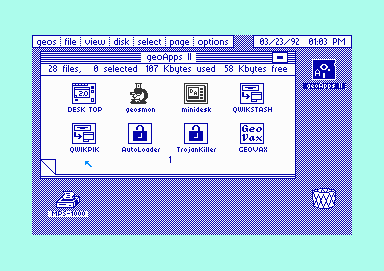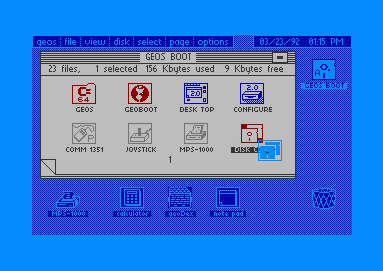
GEOS

GEOS
Introduction:
The GEOS, (Graphical Environment Operating System), was produced by
GeoWorks (more later
Berkeley Softworks) in the far 1986 like integrated graphic interface
(GUI) for Commodore
8-bit computers (Commodore 64 - 128) and others. Some of its
characteristics are use of
the computer by pointing of various functions and click by mouse, "drag
and
drop" function to copy, print, and file erasing; a modern version for
PC exsist (Newdeal inc.).
 The
ambient is integrated,
so applications can easily share data between us by "cut" and
"paste". Thanks to WYSIWYG (What You See Is What
You Get and the
possibility to work with selected text and photos, on 8-bits Commodore
computers the use
of a professional graphic desktop is a reality.
The
ambient is integrated,
so applications can easily share data between us by "cut" and
"paste". Thanks to WYSIWYG (What You See Is What
You Get and the
possibility to work with selected text and photos, on 8-bits Commodore
computers the use
of a professional graphic desktop is a reality.
A versatile system based on drivers let the complete support of new
deviceses: printers,
pointing deviceses, disk drives, etc.
The last GEOS version (2.0) was released in 1988 with REU (ram expansion unit for Commodore 64) support. This feature permits disk caching, multiple access to various drive models, more space for applications, and task-switching.
 Till
now, GEOS support was
provided by third-party distributors (Creative
Micro Designs - Click Here Software);
now it is out of business for Geos & CBM parts support, but Maurice Randall
taken the responsability to
continue a Geos development) and by hobbiest programmers (Maurice
Randall itself, Irv
Cobb, MegaCom, and others). Some fantastic applications have been
written, and continue to
be developed for GEOS, including FAX software, browsers, desktop
publishing applications,
and much more. This page is dedicated to this amazing little operating
system, and all the
fantastic possibilities it provides for Commodore 8-bit computer users.
Till
now, GEOS support was
provided by third-party distributors (Creative
Micro Designs - Click Here Software);
now it is out of business for Geos & CBM parts support, but Maurice Randall
taken the responsability to
continue a Geos development) and by hobbiest programmers (Maurice
Randall itself, Irv
Cobb, MegaCom, and others). Some fantastic applications have been
written, and continue to
be developed for GEOS, including FAX software, browsers, desktop
publishing applications,
and much more. This page is dedicated to this amazing little operating
system, and all the
fantastic possibilities it provides for Commodore 8-bit computer users.
GEOS F.A.Q. v1.1 - frequently asked question
Desktop accessories (screenshots)
Some screenshots about geoWrite (Word processor) and geoPaint (picturemaker) programs
Added applications: geoCalc (spreadsheet), geoFile (database), geoPublisher (desktop publishing), geoChart (graphics)